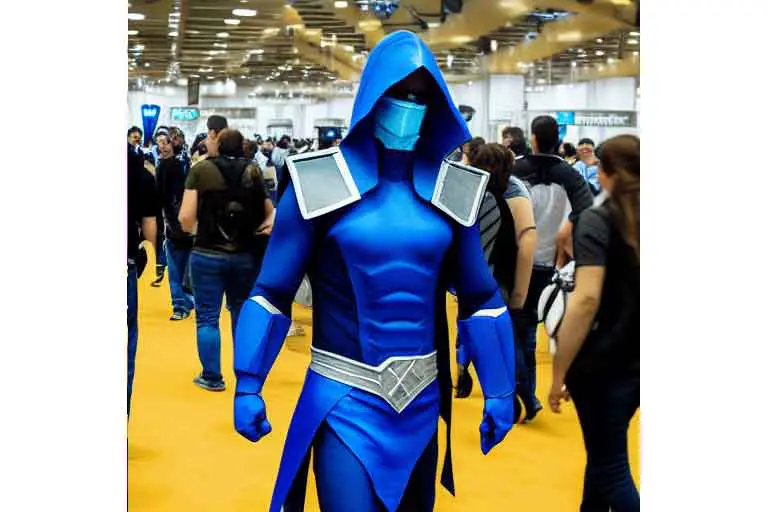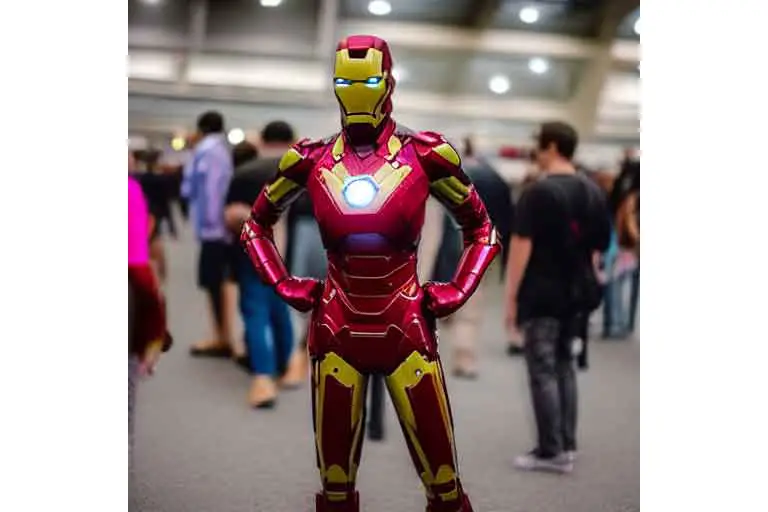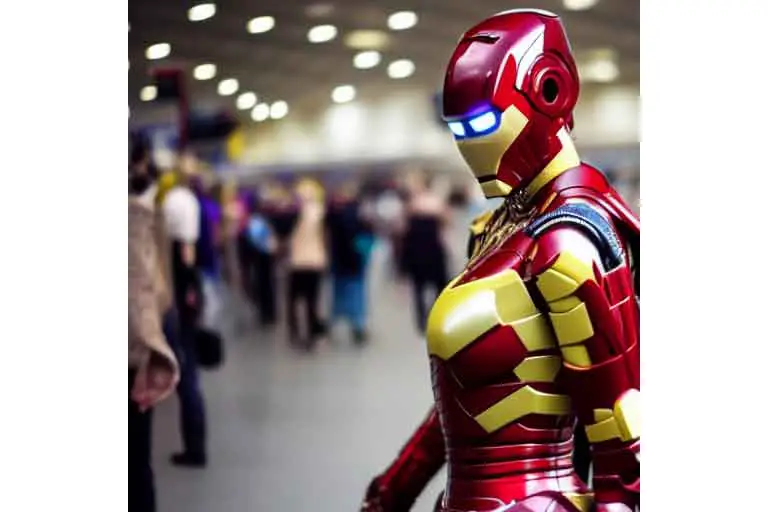Are you a cosplay enthusiast looking for a versatile and easy-to-use material to create your next cosplay costume? Look no further than EVA foam! EVA foam, or Ethylene Vinyl Acetate foam, is a popular material for cosplay crafting due to its lightweight, durability, and ease of shaping and molding.
In this comprehensive guide, we’ll take you through everything you need to know about using EVA foam for your next cosplay project. Our goal is to share our love for cosplay and going to conventions. Most of our readers are beginners, but we will include some more advanced-level tips that are normally user-submitted especially when it comes to creating outfits as we are learning too.
What is EVA Foam?
EVA foam is a type of foam that is used in the manufacturing of athletic shoes, floor mats, and other products that require cushioning. In recent years, it has become increasingly popular among cosplay enthusiasts due to its versatility and ease of use. EVA foam is available in different densities, with high-density foam being more rigid and ideal for creating armor and other structural elements, while the low-density foam is softer and more flexible, making it ideal for creating curved shapes and details. I bought my first EVA foam at Walmart in their automotive section as their budget floor mats.

Getting Started with EVA Foam
Before you start working with EVA foam, it’s important to have the right tools and equipment. You’ll need a heat gun, a sharp knife or scissors, a cutting mat, and a few other basic supplies. We’ve completed a full guide on how to craft cosplay armor. Once you have your supplies, you can start creating your design. The first step is to choose the type of foam you want to use and decide on the design for your costume.
When choosing the type of foam, it’s important to consider the specific requirements of your cosplay. High-density foam is great for creating armor and weapons, while the low-density foam is better suited for creating details and curved shapes. Once you have decided on the type of foam, it’s time to start planning your design.
Before you begin cutting and shaping your foam, it’s a good idea to create a template or sketch of your design. This will help you to visualize the final product and ensure that your measurements are accurate. Once you have your template, you can start cutting and shaping your foam.
Cutting and Shaping EVA Foam
Cutting EVA foam is easy with the right tools. Use a sharp knife or scissors to make clean, straight cuts. A cutting mat can be helpful to protect your work surface. Once you’ve cut your foam into the desired shape, you can start shaping it using a heat gun. Heat the foam until it becomes pliable, then shape it into the desired form. Be careful not to overheat the foam, as this can cause it to warp or deform.
When shaping your foam, it’s important to take your time and work carefully. Use a heat gun to soften the foam and shape it with your hands or tools. You can use a variety of tools to shape your foam, including a Dremel tool, sanding block, and heat gun. We strongly recommend having a heat gun for this, and here’s a link to our favorite (link)
When cutting and shaping your foam, be sure to make clean, straight cuts and smooth out any rough edges with sandpaper. This will ensure that your foam looks professional and polished.

Adding Details to EVA Foam
One of the best things about EVA foam is its ability to hold details. You can use a variety of techniques to add details to your foam, including carving, stamping, and heat embossing. For more intricate details, a Dremel tool can be helpful. The key is to take your time and work carefully to create the desired effect.
When adding details to your foam, it’s important to have a clear plan in mind. Consider the overall design of your cosplay and think about how you can use details to enhance the overall look. For example, if you’re creating armor, you may want to add studs or rivets to give it a more realistic appearance. If you’re creating a prop, you may want to add texture or weathering to make it look more authentic.
There are many different techniques you can use to add details to your foam. One popular method is to use a Dremel tool to carve out intricate designs. Another method is to use heat embossing to create raised details. This involves heating a stamp and pressing it into the foam, leaving a raised impression. You can also use a variety of other tools and materials to create details, including stencils, paint, and glue.
When adding details to your foam, it’s important to take your time and work carefully. Start with a light touch and build up the details gradually. It’s also important to use the right tools and materials for the job. For example, a heat gun may be too powerful for adding small details, while a Dremel tool may be too rough for delicate work.

Painting EVA Foam
Painting EVA foam is the final step in creating your cosplay costume. You can use a variety of methods to paint your foam, including acrylic paint, spray paint, and airbrushing. Before painting, be sure to apply a primer to ensure the paint adheres properly. You can also use a sealant to protect your paint job from wear and tear.
When painting your foam, it’s important to have a clear plan in mind. Consider the overall design of your cosplay and think about how you can use color to enhance the overall look. For example, if you’re creating armor, you may want to use metallic paints to give it a more realistic appearance. If you’re creating a prop, you may want to use weathering techniques to make it look aged and worn.
There are many different techniques you can use when painting your foam. One popular method is to use dry brushing, which involves lightly brushing a contrasting color over a base color to create texture and depth. Another method is to use masking tape to create clean lines and patterns. You can also use a variety of other tools and materials to create different effects, including sponges, stencils, and airbrushes.
When painting your foam, it’s important to take your time and work carefully. Start with a base coat and build up the colors gradually. Use multiple thin layers instead of one thick layer to avoid drips and runs. It’s also important to use the right paint for the job. Acrylic paint is great for beginners and can be easily found at most craft stores, while spray paint and airbrushing require a bit more skill and equipment.
Tips and Tricks for Working with EVA Foam
- Always work in a well-ventilated area when using a heat gun or painting your foam.
- Take your time and work carefully to avoid mistakes.
- Use a sanding block to smooth out any rough edges on your foam.
- Experiment with different techniques to create unique effects.
- Have fun and don’t be afraid to try new things!
Working with EVA Foam
While cutting, shaping, adding details, and painting are the core techniques for working with EVA foam, there are a variety of other techniques you can use to create unique effects.
Weathering
Weathering is the process of making your foam look aged, worn, and lived-in. There are many different techniques you can use to achieve this effect, including dry brushing, sanding, and using a variety of paints and washes. By weathering your foam, you can give it a more realistic and authentic appearance.
Texture
The texture is another way to add depth and dimension to your foam. There are many different ways to create texture, including using a variety of tools and materials to carve, stamp, and emboss your foam. By adding texture to your foam, you can create a more dynamic and visually interesting costume.
Lighting
Lighting can also be used to enhance your foam costume. By adding LED lights or other lighting elements, you can create a stunning visual effect that will make your costume stand out even more. This technique requires a bit more skill and equipment, but it can be a great way to take your cosplay to the next level.

EVA Foam Cosplay Ideas
Many different cosplay ideas can be created using EVA foam. Here are a few examples to get you started:
- Iron Man armor
- Halo Master Chief armor
- Captain America shield
- Overwatch D.Va mech
- Warcraft armor
- Game of Thrones armor and weapons
- Final Fantasy swords and armor
- Star Wars costumes and props
These are just a few examples of the many cosplay ideas that can be created using EVA foam. With the right tools and techniques, you can create amazing costumes and props that will impress your fellow cosplayers and fans alike.
Where to Buy EVA Foam
EVA foam can be purchased at a variety of craft stores and online retailers. Some popular options include:
- Amazon
- Michaels
- Jo-Ann Fabric and Craft Stores
- Foam Factory
- Tandy Leather
- Walmart
When purchasing EVA foam, be sure to consider the density and thickness of the foam, as well as the size and quantity you’ll need for your project.
FAQ: Using EVA Foam for Cosplay
Is EVA foam difficult to work with?
Not at all! EVA foam is a very user-friendly material that is easy to cut, shape, and mold. With the right tools and techniques, anyone can create amazing cosplay costumes and props using EVA foam.
What type of foam should I use for my cosplay project?
The type of foam you should use depends on the specific requirements of your project. High-density foam is great for creating armor and weapons, while the low-density foam is better suited for creating details and curved shapes.
How do I cut and shape EVA foam?
Cutting and shaping EVA foam is easy with the right tools. Use a sharp knife or scissors to make clean, straight cuts. A heat gun can be used to soften the foam and shape it into the desired form.
How do I add details to EVA foam?
There are many different techniques you can use to add details to your foam, including carving, stamping, and heat embossing. The key is to take your time and work carefully to create the desired effect.
Can I paint EVA foam?
Absolutely! EVA foam can be painted using a variety of methods, including acrylic paint, spray paint, and airbrushing. Before painting, be sure to apply a primer to ensure the paint adheres properly.
How do I weather EVA foam?
Weathering is the process of making your foam look aged, worn, and lived-in. There are many different techniques you can use to achieve this effect, including dry brushing, sanding, and using a variety of paints and washes.
How can I create texture on EVA foam?
The texture is another way to add depth and dimension to your foam. There are many different ways to create texture, including using a variety of tools and materials to carve, stamp, and emboss your foam.
Where can I buy EVA foam?
EVA foam can be purchased at a variety of craft stores and online retailers, including Amazon, Michaels, Jo-Ann Fabric, and Craft Stores.
What are some popular cosplay ideas that use EVA foam?
Many different cosplay ideas can be created using EVA foam, including Iron Man armor, Halo Master Chief armor, Captain America shield, and much more.
Wrapping Up
EVA foam is a versatile and easy-to-use material that is perfect for cosplay crafting. With the right tools and techniques, you can create just about anything you can imagine. Whether you’re creating armor, weapons, or props, EVA foam is a great choice for your next cosplay project.
When working with EVA foam, it’s important to take your time and work carefully. Use the right tools and materials for the job, and don’t be afraid to experiment with different techniques to create unique effects. With EVA foam, the possibilities are endless, and you can create amazing cosplay costumes that will impress your fellow cosplayers and fans alike. So why not give it a try and see what amazing creations you can come up with? With EVA foam, the only limit is your imagination!




